|
1.
CENTRAL/ WEST AFRICA
Slow Start to year
The harsh winter weather in northern importing countries
has been the biggest influence on the timber trade in the
first weeks of 2010. Business is slow in most areas.
In Europe many companies closed for up to two weeks
over the Christmas and New Year period and the difficult
weather conditions with snow, ice and below freezing
temperatures are affecting resumption of normal working
of factories, schools and offices and building activity.
Although most consumer countries have technically
moved out of recession, there remain financial problems
especially in UK. Economists, as well as ordinary people,
are aware of a tough year ahead with prospects of higher
taxes and lower trade levels.
In the W. African timber trade the present situation
appears to be of not quite at a standstill but flat, with little
interest reported from buyers in chasing up new purchases.
Log prices have not moved over the past four weeks and
there are few indications as to how the markets will
develop in the first quarter. Sawn lumber prices also have
held very steady over the past few weeks although traded
volumes have been low and business continues at low
levels.
Gabon keeps trade waiting
The uncertain position in relation to the announced ban on
log exports by Gabon has, if anything, exacerbated the
near standstill in the timber sector. After the ban was
announced buyers did immediately begin seeking
alternative log sources but have held back until there is
clarification on the details of the ban.
The SEPBG, the port authority in Gabon has apparently
halted all loading of ships until the situation is made clear.
There are rumors that consideration is being given to
allowing the export of logs already cut until the end of
March.
Other rumours hint of heavy felling to have logs on the
ground in the hope that felled logs could be exported in a
grace period. Other sources hint at a possible
strengthening of existing regulations which require a
commitment to invest in local processing before log
exports are allowed. However, all this is pure speculation
by the trade.
Exports of non-premium logs
On the supply side, the unexpected but timely relaxation
of exports of logs of non-premium species from Cameroon
may well have been a stabilising factor for the W. African
trade. It remains to be seen if log exports from Liberia will
resume in any meaningful volume during 2010.
Logs are still exported from Congo Brazzaville and lately
also from the Democratic Republic of Congo. Whether
these countries can fill the supply gap resulting from a
Gabon ban is far from clear.
China would be the consumer country most affected in the
short term but no doubt would look to increase log
purchases from other countries such as Papua New Guinea
and Solomon Islands, though this would have to be in
alternative species some of which would not be a
substitute for okoume for peeling.
In the medium term the Gabon sawmills and plymills will
have to resume or step up to full production and place
much more emphasis on marketing their processed
timbers. This will not be easy given the slow market
conditions for processed timbers over the past 18 months.
In the meanwhile mills in Ghana and Cameroon have been
working under capacity and might well have a market
advantage, being able to quickly increase production in
response to any increase in demand.

2. GHANA
Export performance
Ghana realised Euro 98 million from its export of
320,660cu.m of wood products in the first nine months of
2009. This compares to 430,081cu.m for the same period
in 2008.
Exports in 2009 (first nine months) fell 25.4% compared
to 2008. This was largely the result of deceased export
volumes in all trading products except air dried lumber,
curls veneer, and plywood.
In the same period there was a 32% drop in revenue
compared to the same period in 2008. The table below
summarises the export performance for the first three
quarters of 2009 compared to the same period in 2008.
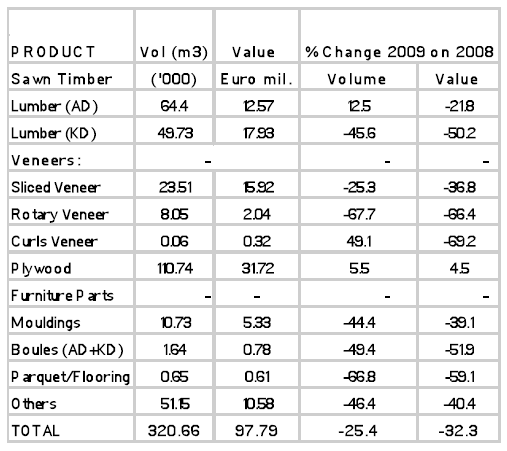
Overland Export Trade
Ghana improved its overland trade performance to the
ECOWAS market in the three quarters to September 2009.
The main products in this trade are air dried lumber and
Plywood and the main markets are Nigeria, Senegal,
Niger, Gambia, Mali, Benin, Burkina Faso and Togo.
These countries altogether absorbed about Eur36 million
of Ghana¡¯s total wood export volumes to neighbouring
African countries. Total trade with other African countries
was worth Euro 42 million (for 168,390 cu.m).
Air dried lumber export by road in 2009 increased
dramatically to 29,000cu.m, from the previous year figures
of 2,514cu.m.
The main species were Chenchen, Mixed White Wood,
Ceiba, Dahoma, and Wawa. The bulk of the exports were
by Rahmusa Company Ltd and Moha-Tony Diasso
Brothers among others.
Overland plywood exports increased by 11% in value for
2009 compared to 2009. Ceiba, Mahogany, Asanfina,
Chenchen and Ofram plywood dominated this trade in
2009.
Inflation eases
The year on year inflation for Ghana fell to 17% in
November 2009, as announced by the Ghana Statistical
Service. In a statement, the Governor of the Central Bank
said Ghana¡¯s inflation rate will ¡ˇădefinitely¡ˇŔ fall in
December 2009 and will continue to ease throughout
2010. ¡ˇăInflation is coming down and it will continue to
come down in the next 12 months,¡ˇŔ the governor told
reporters.

3.
MALAYSIA
Optimism returns
Malaysian timber companies greeted the New Year in a
positive mood now there seems some improvement in
demand.
The global economic slowdown considerably weakened
the demand for Malaysian timber products. In the worst of
the crisis production in Malaysia fell almost 40%, with
plywood and other panel product manufacturers being
hardest hit.
The trade is anticipating growing demand for certified
timber products which will give a boost to products from
plantation timbers.
In addition to the modest improvements in demand for
primary products, producers report that demand for
Malaysian furniture seems to be picking up after a tough
2009.
International buyers are slowly returning to the Malaysian
market after a one year absence it seems. The trade in
Malaysia suggests that the main reasons for their return
even in continuing difficult trading conditions is the high
quality of workmanship and the ability of Malaysian
companies to deliver on time.
Although furniture from China is competitive in terms of
pricing, timely delivery remains a major problem for some
overseas buyers who want just in time deliveries.
ASEAN FTA
The secretary-general of the Malaysian Ministry of
International Trade and Industry (MITI) commented that
the country is ready for the full implementation of the
ASEAN-China free trade agreement (FTA).
Businesses in the country are ready to do business with the
trading bloc of almost 2 billion consumers in ASEAN,
with a combined gross domestic product (GDP) of around
US$5 trillion.
Beginning January 1, 2010, China and the Asean-6,
(Brunei, Indonesia, Malaysia, the Philippines, Singapore
and Thailand), will ensure full implementation of the FTA
by eliminating the duties on up to 90% of products
according to the agreement.
China is Malaysia's fourth largest trading partner, after
Singapore, the US and Japan, with trade in 2008 amounted
to RM130 billion, or 11% of Malaysia's global trade in
total. Malaysia's exports to China in 2008 amounted to
RM63 billion, which accounted for almost one-tenth of
global exports. In the first 3 quarters of 2009, trade with
China amounted to RM89 billion, with exports standing at
RM46.8 billion.
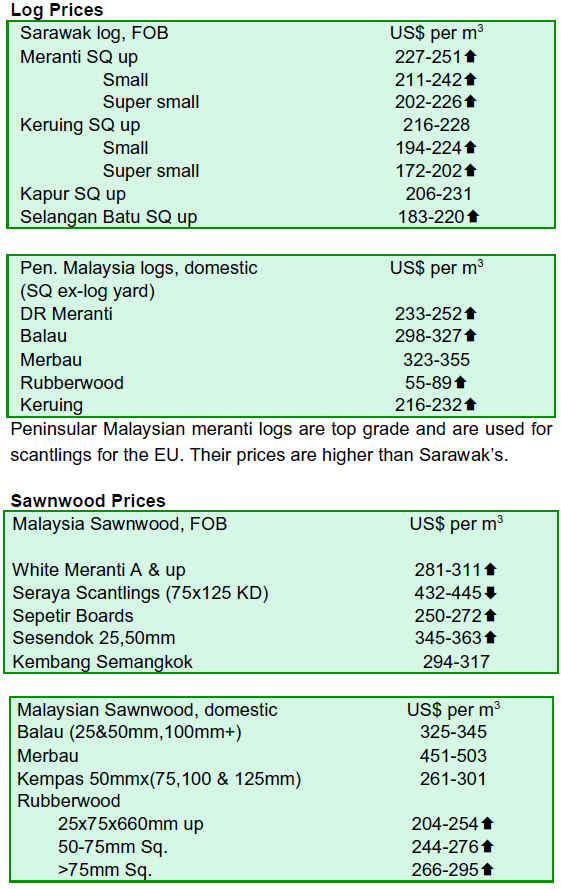
4.
INDONESIA
Competitive China
In contrast to the confident mood in Malaysia, the
chairman of the Association of Indonesian Furniture and
Handicraft Exporters (Asmindo), has reportedly said that
the furniture industry in all ten member countries of
ASEAN share a common appreciation of the challenges
and risks of the ASEAN-China FTA.
In particular Asmindo thinks that furniture producers are
not ready to face the competition from Chinese producers.
The fear expressed is that furniture imports into ASEAN
countries from China could capture a major slice of the
domestic market. Imports currently account for around
30% of the domestic market and this could grow as
imports become cheaper as tariffs are removed.
Currently, there are 314 tariff items from eight sectors
listed under the FTA. Asmindo is said to have been
lobbying the Indonesian authorities to modify or suspend
at least 5 of the 12 tariff items listed within the furniture
sector.
Export performance
Exports of Indonesian timber products, especially
sawnwood and plywood, have been on a decline since
2003, when exports were over 5 million cubic metre
However, exports in the following year fell to 4.5 million
cubic metre; to 3.5 million cubic metre in 2005; 3 million
cubic metre in 2006; 2.9 million cubic metre in 2007, and
1.68 million m3 in 2008.
Total exports for year 2009 only managed to reach 1.2
million cubic metres up to November 2009.
Indonesian timber companies have reportedly said that it is
inappropriate government policies and the failure to grasp
present day market realities had contributed to this decline.
The trade says that while the size of the international
timber market has expanded over the past decade,
Indonesia¡¯s share of that market had declined.
They added that China trade model was good as the sector
has diversified its products and improved its value-added
production technology.
The industry also said that Malaysia is another good
example to emulate; here industries manage pricing of
timber products by spreading costs over a range of
products including logs. Indonesian companies do not
have this opportunity because of a log export ban in
Indonesia.

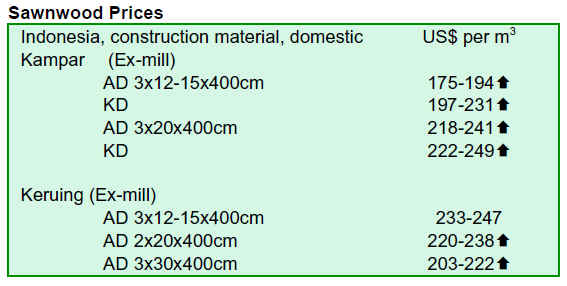
5.
MYANMAR
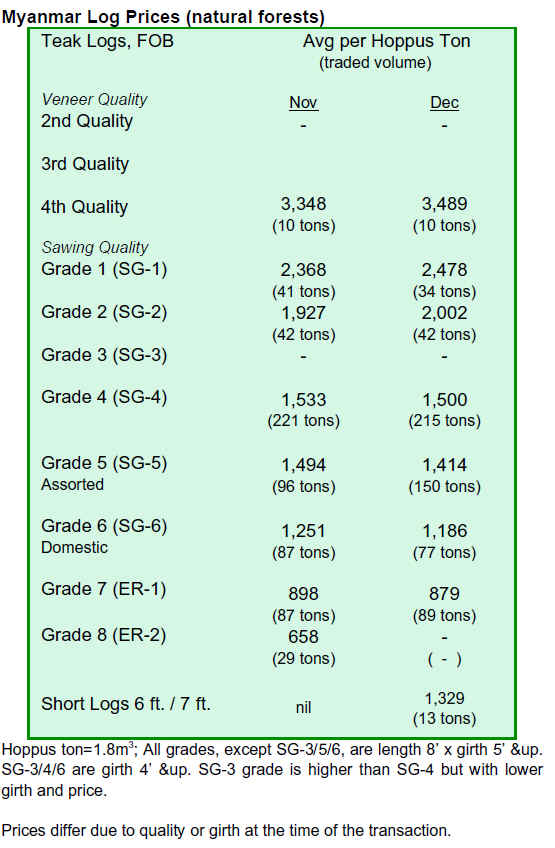
Monthly Teak sales
The monthly Teak sales involve a prior inspection by
buyers and the submission of written tenders for logs. The
logs are available for inspection at Myanmar Timber
Enterprise (MTE) log-yards. These log yards are roughly
within a maximum 30 mile radius from the ports.
Logs sold by tender are mostly shipped within two months
from purchase, but there are instances where shipments
may take longer. MTE may charge ground rent if the logs
are not shipped at the end of three months.
The majority of the shipments made using containers.
Containers are stuffed at MTE container yard and trucked
to the vessels. Buyers, singly or jointly with other buyers,
may also ship using break bulk carriers. The mode of
shipping is left to buyers¡¯ choice.

6. INDIA
Firmly on growth track
Indian exports grew 18% last month and industrial activity
figures show a continuous improvement over the first
three quarters of 2009 with an increase of 11% being
noted in October 2009. This positive economic activity is
helping enormously to create jobs in the country.
After coping with a tough 2009, progress is now seen on
all fronts and as the global economy appears to be
recovering GDP growth forecasts are optimistic. In
December 2009 GDP stood at 7.5% and for 2010-11 it is
expected to be around 9%.
Follow up on Copenhagen
India¡¯s minister for Environments and Forests, Mr.Jairam
Ramesh, has announced that the country¡¯s action plan, as
called for by the Copenhagen Accord, is ready.
India has shown preparedness to reduce emission by 20-25
percent of 2005 levels and that a low carbon growth
strategy will be developed. The minister noted that India¡¯s
per capita carbon emission is among the lowest globally.
Analysts report that builders and architects in India are
considering how to make use of traditional building
materials such as wood, bamboo, limestone and clay.
Consideration is also being given to rainwater harvesting
and the use of solar energy for lighting, water heating and
other purposes.
Industrial plantations
For absorption of carbon dioxide greening programmes are
being mooted. Currently, industrial plantations are being
increasingly established by large private enterprises and on
a small scale by farmers and other landowners.
The government is encouraging the planting of fast
growing and high carbon dioxide absorbing species like
bamboos which also provide raw materials for paper and
rayon pulp and also for rural housing and handicrafts.
The indications are that the government will soon
announce the constitution of an expert group to monitor
low carbon growth strategies in the industrial, transport,
agriculture, building, energy and forestry sectors.
ASEAN FTA activated
As of the1st January 2010 customs duties in India have
been reduced on goods imported from ASEAN countries.
The basic duty on logs has been reduced from 5% to 4%,
on sawn timber from 10% to 7.5 % and on MDF,
particleboards, plywood, veneer sheets and soft boards
from 10% to 7.5%.
Trade news
Sales of Teak and other hardwoods by auctions have
continued in Gujarat, Central India and Kerala and reports
are confirming firm prices and brisk sales of freshly felled
timber that has been arriving post monsoon. Quality
standards are being well maintained it is reported.
For past several months the trade has said that the quality
of logs coming from Myanmar has not been very
satisfactory so local manufacturers are opting to pay a
little more and buy the local hardwoods.
Continuous PB line
Wood News in India has reported the awarding of a
contract for first ever continuous Particleboard Production
line by Star Panel Boards Ltd. Bangalore to Dieffenbacher
of Germany.
The plant is apparently designed for a daily capacity of
over 1000 cubic metres. Full commercial production is
forecast to begin in 2011. This domestic production will
narrow the gap between demand and local supply and
reduce India¡¯s dependence on imports.
Wood sailing vessels
In other news, the Economic Times of India has reported
brisk business for coastal sailing vessels being built at
Mandvi Kutch, an area famous for this craft for centuries,
because of the highly skilled local workforce and the
proximity of the Teak forests of Dangs. Timbers from
Malaysia are also used in the making of these boats which
comes to Kandla.
The size of vessels being built range from 150 to 1500
tones capacity and these vessels are used to carry goods
the Middle Eastern and North African countries. Ship
builders are saying that their order books are full up to
2012.
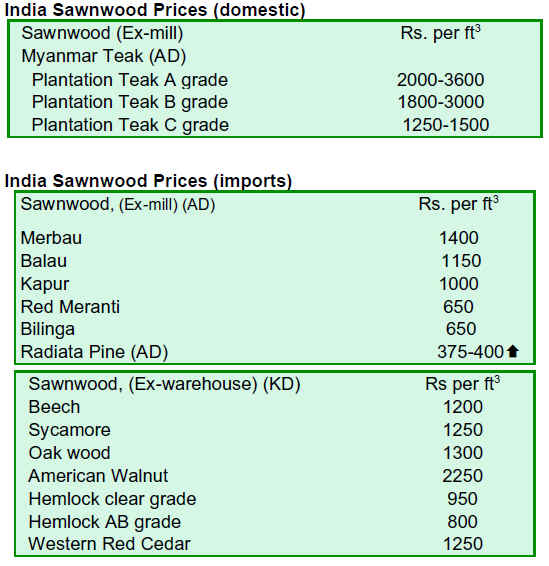
7. BRAZIL
Exports Drop in Alta Floresta
Contrary to exports in Sinop, Sorriso, Lucas do Rio Verde
and Nova Mutum, wood products export from the
municipality of Alta Floresta, a major regional timber
exporter, dropped between January and November 2009,
compared to the same period of 2008.
The value of exports reportedly dropped from US$ 12.7
million to US$ 10.8 million. The non-conifers products
trade was worth US$ 9.6 million, a 6.8% reduction
compared to 2008, when it reached US$ 10.3 million.
As for the main export product, sawnwood wood with a
thickness exceeding 6 mm, trade totaled US$ 363,800
(-81% from Jan-Nov 2009 compared to the previous
period); wood block, planks, veneer and wood
frames/profiles, however were traded for US$ 305,200
(+684%) and ipˇ§º wood products earned just US$ 194,400
(-47%).
The main export destinations for products from Alta
Floresta are the United States (US$ 5.7 million), Canada
(US$ 1.7 million) and Spain (US$ 1 million).
Wood furniture cheaper
A tax exemption scheme on furniture has been in force
since November 27, 2009. The tax on such products varies
between 5% and 10%. Some furniture companies had
suggested that they could pass on to consumers a price
reduction greater than the tax break. According to the
Association of Furniture Industry of Rio Grande do Sul
(Movergs), the main cluster of the furniture industry in the
country, the measure may lead to a fall of about 20% in
prices consumer pay.
According to furniture entrepreneurs, even though it is too
early to analyze the impact, there are signs of a recovery in
sales.
The Brazilian Furniture Manufacturers Association
(ABIMÓVEL) says that the sector is facing a crisis as a
result of the average drop of 10% in sales in 2009. The
Association expects that between December 2009 and
March 2010 it will be possible to recover about 25% of
sales.
In the wood furniture clusters of Ubˇ§¢, Linhares and
Arapongas, where there is a high proportion of exports,
there was a drop of up to 25% in sales in recent months.
With declining exports, the companies now began to
depend more on the domestic market.
Fighting Illegal Logging
By November 2009 the Brazilian Federal Police had
seized some 9,000 cubic metres of illegally transported
and processed timber in Northern Mato Grosso. The police
have mounted the longest operation to fight illegal logging
activities in the region.
The operations are coordinated by the Federal Police in
Mato Grosso, and also implemented in the states of Parˇ§¢,
Rondônia and Maranhão, in the Brazilian Amazonia.
In Mato Grosso, there are two operational bases of the
"Arco de Fogo" operation: one each in the municipalities
of Juˇ§ªna and Sinop.
In this operation, 30 federal policemen and 30 officers
from the National Force for Public Safety are working. In
addition to the seized timber, 100 cubic metres of
illegally-produced charcoal were seized and 221 furnaces
destroyed.
The Brazilian Institute of Environment and Renewable
Resources (IBAMA) will soon reveal the total amount of
fines levied against companies in the "Arco de Fogo II
Operation", carried out between January and April 2009.
The fight against illegal logging and timber smuggling in
the Amazon has so far resulted in R$31.3 million in fines.
According to IBAMA, the majority of fines were imposed
on timber companies for raw material storage or sale
without license.
The Amazon Fund
The Brazilian Forest Service and the Chico Mendes
Institute for Biodiversity Conservation (ICMBio) may
receive Euro 15 million from the German government,
through the KfW Development Bank. This money would
be to develop the project ¡®Support Forest Management for
Sustainable Production in the Amazon¡¯.
The German donation would support activities in the
forest concessions and will help the Forest Service to
improve the infrastructure of regional units in Porto Velho
(RO) and Santarˇ§¦m (PA), and to set up an additional four
offices in the Amazon.
The funds would also support the demarcation of some
national forests, preparation of management plans and
implementation of advisory boards for national forests
(FLONAs) by ICMBio, which are prerequisites for a forest
concession.
In other news, the Government of Norway has announced
an increase in its contribution to the Amazon Fund to US$
150 million in 2010, apparently after seeing evidence of
deforestation reduction in the region.
The Fund was created by the Brazilian government in
2008 aimed at reducing deforestation in the region and the
fund is managed by the National Development Bank
(BNDES).
According to recent data, deforestation in the Brazilian
Amazon between July 2008 and June 2009 was 65% less
than the average recorded between 1996 and 2005 and
over 40% below the deforestation rate of the previous
year. These results are yet to be verified.
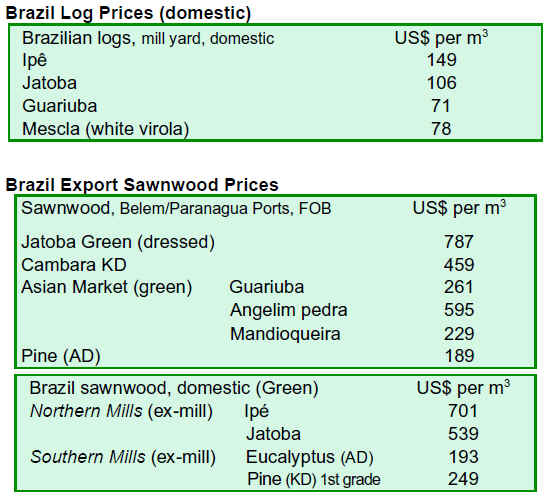
8.
PERU
2009 exports down 34%
According to data from the Export Association of Peru
(ADEX), wood sector exports from January ˇ§C November
2009 were of US$135.09 million FOB, down 33.6% on
the same period in 2008.
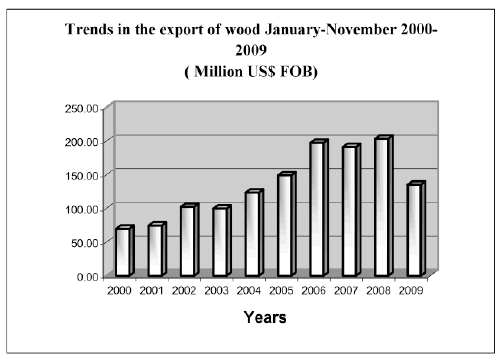
The three main export markets were China, Mexico and
the United States, accounting for over 80% exports of
wood products. The New Zealand market was significant
in 2009 taking volumes of railway ties. On the other hand,
the Mexican market remained subdued and imports from
Peru fell over 60% and no exports of mouldings were
recorded in 2009.

Peru¡¯s export data up to November 2009 shows the
weakening of Canadian demand (-65%) and a similar
picture emerged for the Hong Kong market which fell
38% in 2009.
Semi-manufactured products accounted for 42% of
exports from January to November 2009 and were worth
US$56.38 million FOB compared to US$63.44 million
FOB for 2008 (-11%).
The main market for semi-finished wood products was
China represents 77% of the total. Chinese imports from
Peru grew almost 50% in 2009.
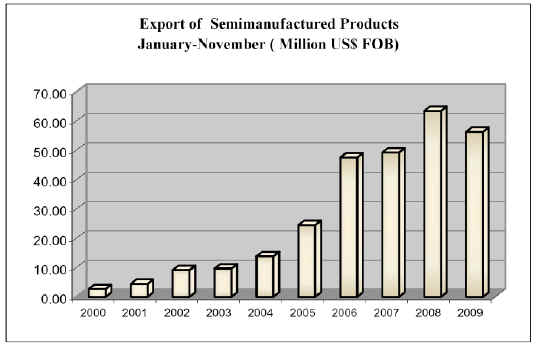
Sawnwood represented the second major wood product
export item in 2009. The value of exports of sawnwood
January ˇ§C November 2009 was US $ 49.29 million FOB
down 46% on a year earlier.
The main market for sawnwood from Peru was China
which took around 34% of the total sawnwood exports.
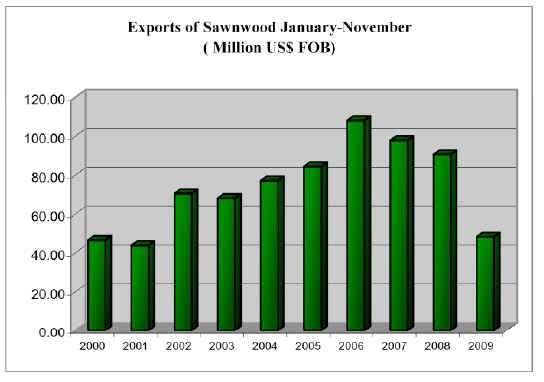
The value of veneer and plywood exports up to November
2009 stood at US$13.67 million FOB but this was down
47% on a year earlier.
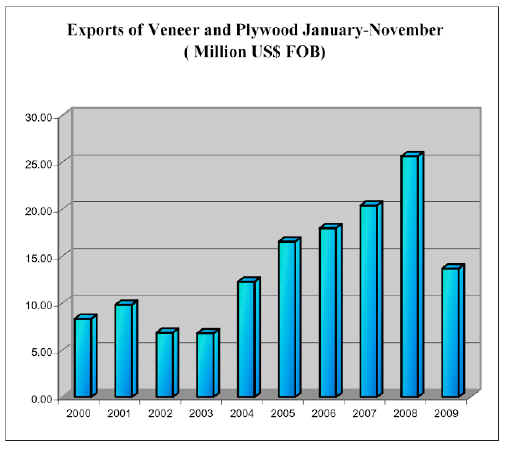
The main destination for veneer and plywood from Peru
was Mexico (83% of total product exports). Mexican
imports from Peru were affected by weak demand in the
US for processed products and consequently Mexico¡¯s
imports from Peru declined.
The exports of furniture and parts up to November 2009
were worth US$6.74 million FOB compared to US$11.81
million FOB in 2008 and this represents a fall 43%. The
main market for exports in this sub-sector is the United
States, accounting for 49% of all furniture and parts
exports but up to November 2009 US imports had dropped
53%.

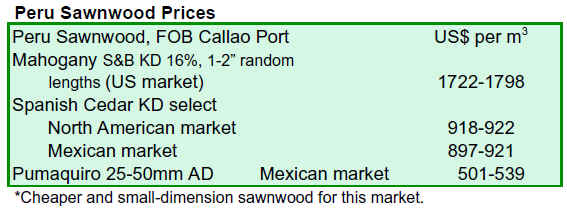
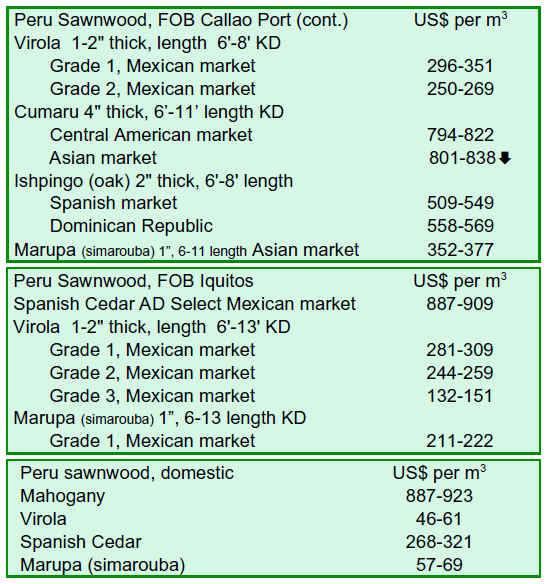
8.
Guyana
Price movements
Prices for Greenheart logs remain were relatively stable.
Purpleheart standard sawmill quality prices climbed while
Mora log prices stayed firm.
Sawnwood prices were highly favourable over the past
weeks. Prices for dressed local Washiba, internationally
traded as Ipe, went as high as US$1600 per cu.m. Nondressed
Greenheart prices recorded modest gains in the
prime class while the select category experienced a decline
in prices.
Only prices for Purpleheart select moved up to a fairly
good average price while Mora prices remained stable.
Dressed Greenheart average prices were favourable
recently and dressed Purpleheart enjoyed buoyant prices.
Plywood prices eased slightly for BB/CC qualities.
Value added products, mainly door and door sets as well
as indoor furniture and mouldings recorded higher average
prices than in late 2009.
Log tracking strengthened
The Guyana Forestry Commission recently reported on
ITTO supported efforts to improve the detection and
prevention of illegal harvesting and trade in the country.
Part of this work involved the improvement of Guyana¡¯s
log tracking system. In 2001, a national log tracking
system was implemented and was monitored through
manual verification. Under this system, cut logs and
stumps are identified using a plastic barcode tag that is
attached immediately after logging or when logs are
converted into pieces at timber collection points.
The manual implementation of this system however, did
not allow for the full benefits of traceability and
verification of origin, to be realized. This aspect of the
work recently undertaken aimed at helping prevent illegal
logging and trade in illegally harvested timber by utilizing
a timber tracking system based on barcode utilization in
the harvesting of tropical forests, shipment and exporting
stages.
Forest carbon stock assessment
The Government of Guyana has embarked on a national
programme that aims to continue to maintain the
sustainable management of its forest as a contribution to
climate change mitigation. It is anticipated that this effort
will attract international resources to foster growth and
development along a low carbon emissions path.
As an initial step to the implementation of a monitoring,
reporting and verification (MRV) for Guyana, a road map
for the development of a MRV system for REDD+
participation for Guyana was designed following a
stakeholder participation session.
The Guyana Forestry Commission, on behalf of the
Government of Guyana, has indicated that it requires the
services of an experienced remote sensing and GIS
consultant to undertake comprehensive, consistent and
transparent assessment of forest area change.
More information on this call for proposal can be found at
the Guyana Forestry Commission¡¯s website at
www.forestry.gov.gy
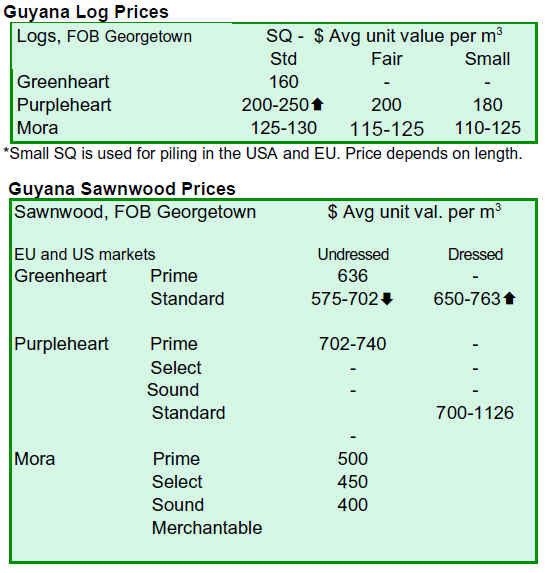
|